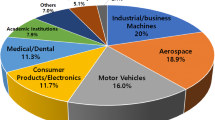Abstract
Additive layer manufacturing is growing very fast in various industries such as biomedical, aircraft, and aerospace industries. There is a need for developing simulation tools for predicting transient temperature fields in additive layer manufacturing of three-dimensional (3D) complex parts in these industries. Transient temperature fields in additive manufacturing are critical due to the fact that transient temperatures directly affect residual stresses, microstructure, fatigue life, 3D distortions, and deformations of produced parts. Considering this industrial need, this article introduces a new approach to 3D transient thermal analysis for additive manufacturing for 3D complex industrial structures with freeform features in powder bed systems using laser heat source. Incorporating the features of phase changes, porous media, and temperature-dependent thermal material properties in COMSOL Multiphysics, the developed technique is able to simulate instantaneous transient temperature fields in additive layer manufacturing of 3D complex and freeform structures. Temperature model validations are performed on titanium alloy with the experimental temperature measurements available in the literature. It is observed that the predicted model simulation results agree well with the experimental measurements.
Similar content being viewed by others
References
Levy GN (2010) The role and future of the laser technology in the additive manufacturing environment, 2010 Inspire Institute for Rapid Product Development. Phys Procedia 5(Part A):65–80
Jaeger JC (1942) Moving sources of heat and the temperature at sliding contacts. Proc Royal Soc 76:203–224
JunChang L, Langlade C, Vannes AB (1999) Evaluation of the thermal field developed during pulsed laser treatments: semi analytical calculation, China. Surf Coat Technol 115(1):87–93
Matsumoto M, Shiomi M, Osakada K, Abe F (2002) Finite element analysis of single layer forming on metallic powder bed in rapid prototyping by selective laser processing. Int J Mach Tools Manuf 42(1):61–67
Tolochko NK, Arshinov MK, Gusarov AV, Titov VI, Laoui T, Froyen L (2003) Mechanism of selective laser sintering and heat transfer in Ti powder. Rapid Prototyp J 9(5):314–326
Cervera GBM, Lombera G (1999) Numerical prediction of temperature and density distributions in selective laser sintering processes. Rapid Prototyp J 5(1):21–26
Yang J, Wang F (2009) 3D finite element temperature field modeling for direct laser fabrication. Int J Adv Manuf Technol 43:1060–1068
Nisar A, Schimidt MJJ, Sheikh MA, Li L (2003) Three-dimensional transient finite element analysis of the laser enamelling process and moving heat source and phase change considerations. Proc Institution Mech Eng -Part B - Eng Manuf 217(6):753–764
Kolossov S, Boillat E, Glardon R, Fischer P, Locher M (2004) 3D FE simulation for temperature evolution in the selective laser sintering process. Int J Mach Tools Manuf 44(2–3):117–123
Roberts IA, Wang CJ, Esterlein R, Stanford M, Mynors DJ (2009) A three-dimensional finite element analysis of the temperature field during laser melting of metal powders in additive layer manufacturing. Int J Machine Tools Manuf 49:916–923
Hussein A, Liang H, Yan C, Everson R (2013) Finite element simulation of the temperature and stress fields in single layers built without-support in selective laser melting. Mater Des 52:638–647
Song B, Dong S, Liao H, Coddet C (2012) Process parameter selection for selective laser melting of Ti6Al4V based on temperature distribution simulation and experimental sintering. Int J Adv Manuf Technol 61:967–974
Zhiqiang F, Liou F (2012) Numerical modeling of the additive manufacturing (AM) processes of titanium alloy, titanium alloys—towards achieving enhanced properties for diversified applications, Dr. A.K.M. Nurul Amin (Ed.), ISBN: 978-953-51-0354-7, InTech
Sih SS, Barlow JW (2004) The prediction of the emissivity and thermal conductivity of powder beds. Particulate Sci Tech: An Int J 22(3):291–304
Mills KC (2002) Recommended values of thermophysical properties for selected commercial, ISBN: 978-1-85573-569-9. Woodhead Publishing, Cambridge
Patankar SV (1980) Numerical heat transfer and fluid flow. McGraw-Hill, New York
Fischer P, Locher M, Romano V, Weber HP, Kolossov S, Glardon R (2004) Temperature measurements during selective laser sintering of titanium powder. Int J Mach Tools Manuf 44(12–13):1293–1296
Shen X-F, Wang Y, Yao J, Yan J-L (2005) Finite element simulation of thermal distribution in direct metal laser multi-track sintering. J Sichuan Univ (Eng Sci Edition) 37(1):47–51
Author information
Authors and Affiliations
Corresponding author
Rights and permissions
About this article
Cite this article
Kundakcioglu, E., Lazoglu, I. & Rawal, S. Transient thermal modeling of laser-based additive manufacturing for 3D freeform structures. Int J Adv Manuf Technol 85, 493–501 (2016). https://doi.org/10.1007/s00170-015-7932-2
Received:
Accepted:
Published:
Issue Date:
DOI: https://doi.org/10.1007/s00170-015-7932-2




